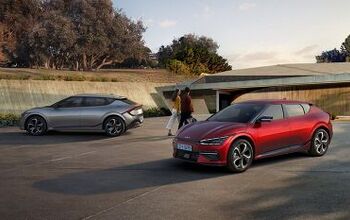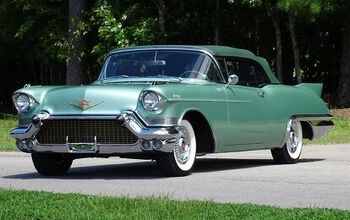Driving Dystopia: Pickup Sales Are Probably Going to Decline in the UK

A British friend of mine recently asked my opinion on several vehicle models, saying he was browsing company cars. What I assumed would be a quick chat quickly devolved into my being educated on British tax codes, especially the benefit-in-kind (BIK) taxes applied to any items of value provided to employees. While familiar with the concept, I was not ready to traverse the graphs and tables required to determine how much you’re on the hook for depending upon what type of vehicle you’ve chosen.
For corporate automobiles that also see private use, benefit-in-kind taxes are calculated as a perk on top of the base salary. Normal to my American eyes thus far. One would expect to receive some kind of purchasing allowance calculated that’s then tied to income. There may even be mileage reimbursements that have to be taken into account, depending upon local laws and your employer. But things aren’t quite as simple as that in the United Kingdom.
Rather than simply pegging corporate car allowances primarily to income, Britain’s BIK taxes also take into account what kind of vehicle you’re driving and whether it has an exhaust pipe. Digging into the concept resulted in a lot of angry and confused comments and a recent article from Autocar stipulating that commercial trucks doubling as normal transportation are about to become prohibitively expensive as most are poised for a “near-fivefold increase in personal tax bills" after July 1st, 2024.
From Autocar:
Currently, any pick-up that meets the criteria of having a payload of more than 1000kg (or 1045kg with a hardtop installed) is considered a commercial vehicle.
This is in line with the current VAT rules, allowing business users to reclaim tax on vans and pick-ups.
From 1 July, HRMC will abandon the payload-based definition and deem any pick-up with a second row of seats as suitable for private use and therefore a car.
Due to favourable VAT and BIK taxation, the UK is one of the largest markets in Europe for pick-up trucks.
The Ford Ranger is the country’s best-selling example, with 18,679 registrations for a 45.5 [percent] market share in 2023.
The most popular Wildtrak variant with a 2.0-litre diesel engine has a basic list price of £47,220 including VAT. Under the new rules, its 230g/km CO2 emissions place it in the top BIK taxation group of 37 [percent].
A 20 [percent] taxpayer in England will therefore have to pay £291 per month and a 40 [percent] taxpayer £582 per month in BIK tax for having it as a company car.
This compares to a flat rate of just £60 per month for 20 [percent] taxpayers or £120 per month for 40 [percent] taxpayers at present.
Dumbed down to the simplest explanation, that amount of taxes owed equates to a combination of income, vehicle price and carbon-dioxide emissions. This is in addition to the Value-Added Tax (VAT), which doesn’t exist in the United States but assesses taxes on the “value added” in each production stage of a good or service in the United Kingdom.
While just about everyone writing from the UK is trying to frame the scheme as simple and fair, these are some lofty rates and it still requires someone to go out of their way to calculate the above before purchasing unless they’re keen on unpleasant surprises. This is because emissions can vary dramatically even between trims of otherwise identical models.
Considering how heavily emissions are weighted, powertrain options obviously come into play here. But so do things like wheel size, engine mapping, and any features that might add a meaningful amount of weight, thereby impacting the product's overall efficiency. Since the final price of the vehicle also plays into the tax, vehicles may likewise be accidentally configured to slot into a higher tax bracket. Gone are the days where you just bought a work vehicle based on its sticker price and capabilities. Someone in the market for a company vehicle now has to consider novel tax schemes and where the automobile will be allowed to venture without fines based on how (or whether) it qualifies to traverse ultra low emissions zones (ULEZ) and congestion areas.
As you might have guessed, UK vehicles are taxed on a tiered system that favors electrification. “Real Driving Emissions Step 2” (RDE2) has likewise introduced new emission rules that require gasoline and diesel driven automobiles to have on-road emissions output effectively match laboratory testing. Buying a used vehicle built before 2021 likely won’t comply with RDE2 and will therefore see an additional 4-percent tax atop what will undoubtedly be the highest BIK tax bracket — which tops out at 37 percent.
Previous rates didn’t even include battery powered automobiles. However, they’re currently subjected to a 2 percent tax which isn’t even enough to offset the purchasing subsidies being offered by the government in most cases.
Plug-in hybrids are the most difficult category to assess. Regulators have opted to establish tax brackets based upon how much driving the vehicle can do without having to use the combustion motor. Unfortunately, the target metrics are extremely high. Cars capable of all-electric ranges surpassing 130 miles will fall into the same 2-percent category as true EVs. But no automaker yet sells a car capable of doing that, meaning most PHEVs will be subjected to rates in excess of 8 percent.
While the final payout depends heavily on income, we can use the percentages to estimate the annual tax. For small-engine passenger vehicles ballparking around £25,000, you can expect to pay somewhere around £1,500 annually in BIK taxes. But that presumes you’re in the basic tax bracket. The highest bracket would nearly double that rate. The same thing happens for those who elect to buy a larger vehicle with a stouter powertrain. Basically, if you’re driving something with an MSRP below £35,000 emitting more than 130g/km (which would include practically every 2.0-liter engine currently on sale) you’re going to be spending a minimum of £2,200 in BIK taxes each year — or $5,000 per year if you’re in a higher income segment.
And the amount continues to increase as you opt for more expensive vehicles boasting larger powertrains, which is another reason why the new tax scheme effectively makes commercial pickups more trouble than they’re worth. Meanwhile, EVs are simply tied to that base 2 percent due to not having any tailpipe emissions to calculate. Drivers would be hard pressed to see annual BIK taxes exceeding a few hundred dollars (er… pounds) on any electric car retailing below £50,000.
As the scheme is effectively designed to incentivize businesses to purchase electrified automobiles, hybrids tend to fall somewhere in the middle. However, the tax rate will always be far lower than what’s allotted to combustion-only vehicles — especially if the hybrid is of the plug-in variety and has the ability to operate entirely on electric power for a few miles.
As an American, all of the above sounds borderline insane to your author. But it’s worth keeping in mind that the United Kingdom is less car-focused than the United States and didn’t stage an entire revolution on the basis of overbearing taxes being morally unacceptable. Driving distances in the British Isles are far shorter with public transportation being more commonplace and arguably better. Vehicle ownership in the UK is about half of what it is on the other side of the Atlantic Ocean. However, many jobs still require some form of personal conveyance and the British government spent years providing financial incentives to companies offering company car allowances.
Things started to change after many businesses started engaging in cost-cutting measures and the government started to pull back on corporate assistance schemes around 2016. This resulted in a 25-percent loss of company cars since then and coincided with a general decline in automotive sales inside the UK. New vehicle sales went from 2.7 million units in 2016 to just 1.6 million by 2022. While government regulators are dead-set on driving up EV volumes they’re also convinced that returning incentives may likewise drive up waning automotive sales in general.
We’ll see about that.

A staunch consumer advocate tracking industry trends and regulation. Before joining TTAC, Matt spent a decade working for marketing and research firms based in NYC. Clients included several of the world’s largest automakers, global tire brands, and aftermarket part suppliers. Dissatisfied with the corporate world and resentful of having to wear suits everyday, he pivoted to writing about cars. Since then, that man has become an ardent supporter of the right-to-repair movement, been interviewed on the auto industry by national radio broadcasts, driven more rental cars than anyone ever should, participated in amateur rallying events, and received the requisite minimum training as sanctioned by the SCCA. Handy with a wrench, Matt grew up surrounded by Detroit auto workers and managed to get a pizza delivery job before he was legally eligible. He later found himself driving box trucks through Manhattan, guaranteeing future sympathy for actual truckers. He continues to conduct research pertaining to the automotive sector as an independent contractor and has since moved back to his native Michigan, closer to where the cars are born. A contrarian, Matt claims to prefer understeer — stating that front and all-wheel drive vehicles cater best to his driving style.
More by Matt Posky
Latest Car Reviews
Read moreLatest Product Reviews
Read moreRecent Comments
- Redapple2 I gave up on Honda. My 09 Accord Vs my 03. The 09s- V 6 had a slight shudder when deactivating cylinders. And the 09 did not have the 03 's electro luminescent gages. And the 09 had the most uncomfortable seats. My brother bought his 3rd and last Honda CRV. Brutal seats after 25 minutes. NOW, We are forever Toyota, Lexus, Subaru people now despite HAVING ACCESS TO gm EMPLOYEE DISCOUNT. Despite having access to the gm employee discount. Man, that is a massive statement. Wow that s bad - Under no circumstances will I have that govna crap.
- Redapple2 Front tag obscured. Rear tag - clear and sharp. Huh?
- Redapple2 I can state what NOT to buy. HK. High theft. Insurance. Unrefined NVH. Rapidly degrading interiors. HK? No way !
- Luke42 Serious answer:Now that I DD an EV, buying an EV to replace my wife’s Honda Civic is in the queue. My wife likes her Honda, she likes Apple CarPlay, and she can’t stand Elon Musk - so Tesla starts the competition with two demerit-points and Honda starts the competition with one merit-point.The Honda Prologue looked like a great candidate until Honda announced that the partnership with GM was a one-off thing and that their future EVs would be designed in-house.Now I’m more inclined toward the Blazer EV, the vehicle on which the Prologue is based. The Blazer EV and the Ultium platform won’t be orphaned by GM any time soon. But then I have to convince my wife she would like it better than her Honda Civic, and that’s a heavy lift because she doesn’t have any reason to be dissatisfied with her current car (I take care of all of the ICE-hassles for her).Since my wife’s Honda Civic is holding up well, since she likes the car, and since I take care of most of the drawbacks of drawbacks of ICE ownership for her, there’s no urgency to replace this vehicle.Honestly, if a paid-off Honda Civic is my wife’s automotive hill to die on, that’s a pretty good place to be - even though I personally have to continue dealing the hassles and expenses of ICE ownership on her behalf.My plan is simply to wait-and-see what Honda does next. Maybe they’ll introduce the perfect EV for her one day, and I’ll just go buy it.
- 2ACL I have a soft spot for high-performance, shark-nosed Lancers (I considered the less-potent Ralliart during the period in which I eventually selected my first TL SH-AWD), but it's can be challenging to find a specimen that doesn't exhibit signs of abuse, and while most of the components are sufficiently universal in their function to service without manufacturer support, the SST isn't one of them. The shops that specialize in it are familiar with the failure as described by the seller and thus might be able to fix this one at a substantial savings to replacement. There's only a handful of them in the nation, however. A salvaged unit is another option, but the usual risks are magnified by similar logistical challenges to trying to save the original.I hope this is a case of the seller overvaluing the Evo market rather than still owing or having put the mods on credit. Because the best offer won't be anywhere near the current listing.


































Comments
Join the conversation
"As an American, all of the above sounds borderline insane to your author. "
It still makes better sense than CAFE, and it's not like the US has never used tax policy to influence public policy or behavior.
That's a lot of tax!